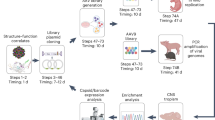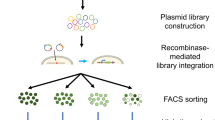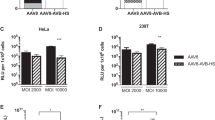Abstract
Characterizing the molecular diversity of the cell surface is critical for targeting gene therapy. Cell type–specific binding ligands can be used to target gene therapy vectors. However, targeting systems in which optimum eukaryotic vectors can be selected on the cells of interest are not available. Here, we introduce and validate a random adeno-associated virus (AAV) peptide library in which each virus particle displays a random peptide at the capsid surface. This library was generated in a three-step system that ensures encoding of displayed peptides by the packaged DNA. As proof-of-concept, we screened AAV-libraries on human coronary artery endothelial cells. We observed selection of particular peptide motifs. The selected peptides enhanced transduction in coronary endothelial cells but not in control nonendothelial cells. This vector targeting strategy has advantages over other combinatorial approaches such as phage display because selection occurs within the context of the capsid and may have a broad range of applications in biotechnology and medicine.
This is a preview of subscription content, access via your institution
Access options
Subscribe to this journal
Receive 12 print issues and online access
$209.00 per year
only $17.42 per issue
Buy this article
- Purchase on Springer Link
- Instant access to full article PDF
Prices may be subject to local taxes which are calculated during checkout




Similar content being viewed by others
Change history
17 August 2003
HTML updated
References
Somia, N. & Verma, I.M. Gene therapy: trials and tribulations. Nat. Rev. Genet. 1, 91–99 (2000).
McCormick, F. Cancer gene therapy: fringe or cutting edge? Nat. Rev. Cancer 1, 130–141 (2001).
Marshall, E. Gene therapy a subject in leukemia-like disease. Science 298, 34–35 (2002).
Wickham, T.J. Targeting adenovirus. Gene Ther. 7, 110–114 (2000).
Trepel, M., Arap, W. & Pasqualini, R. In vivo phage display and vascular heterogeneity: implications for targeted medicine. Curr. Opin. Chem. Biol. 6, 399–404 (2002).
Larochelle, A., Peng, K.W. & Russell, S.J. Lentiviral vector targeting. Curr. Top. Microbiol. 261, 143–163 (2002).
Pasqualini, R. & Ruoslahti, E. Organ targeting in vivo using phage display peptide libraries. Nature 380, 364–366 (1996).
Arap, W. et al. Steps toward mapping the human vasculature by phage display. Nat. Med. 8, 121–127 (2002).
Barry, M.A., Dower, W.J. & Johnston, S.A. Toward cell-targeting gene therapy vectors: selection of cell-binding peptides from random peptide-presenting phage libraries. Nat. Med. 2, 299–305 (1996).
Laakkonen, P., Porkka, K., Hoffman, J.A. & Ruoslahti, E. A tumor-homing peptide with a targeting specificity related to lymphatic vessels. Nat. Med. 8, 751–755 (2002).
Trepel, M., Arap, W. & Pasqualini, R. Modulation of the immune response by systemic targeting of antigens to lymph nodes. Cancer Res. 61, 8110–8112 (2001).
Ellerby, H.M. et al. Anti-cancer activity of targeted pro-apoptotic peptides. Nat. Med. 5, 1032–1038 (1999).
Curnis, F. et al. Enhancement of tumor necrosis factor α antitumor immunotherapeutic properties by targeted delivery to aminopeptidase N (CD13). Nat. Biotechnol. 18, 1185–1190 (2000).
Bartlett, J.S., Kleinschmidt, J., Boucher, R.C. & Samulski, R.J. Targeted adeno-associated virus vector transduction of nonpermissive cells mediated by a bispecific F(ab 'gamma)(2) antibody. Nat. Biotechnol. 17, 181–186 (1999).
Reynolds, P.N. et al. A targetable, injectable adenoviral vector for selective gene delivery to pulmonary endothelium in vivo. Mol. Ther. 2, 562–578 (2000).
Nettelbeck, D.M. et al. Targeting of adenovirus to endothelial cells by a bispecific single-chain diabody directed against the adenovirus fiber knob domain and human endoglin (CD105). Mol. Ther. 3, 882–891 (2001).
Ponnazhagan, S., Mahendra, G., Kumar, S., Thompson, J. & Castillas, J.M.J. Conjugate-based targeting of recombinant adeno-associated virus type 2 vectors by using avidin-linked ligands. J. Virol. 76, 12900–12907 (2002).
Trepel, M., Grifman, M., Weitzman, M.D. & Pasqualini, R. Molecular adaptors for vascular-targeted adenoviral gene delivery. Hum. Gene Ther. 11, 1971–1981 (2000).
Nicklin, S.A. et al. Efficient and selective AAV2-mediated gene transfer directed to human vascular endothelial cells. Mol. Ther. 4, 174–181 (2001).
Grifman, M. et al. Incorporation of tumor-targeting peptides into recombinant adeno-associated virus capsids. Mol. Ther. 3, 964–975 (2001).
Monahan, P.E. & Samulski, R.J. AAV vectors: is clinical success on the horizon? Gene Ther. 7, 24–30 (2000).
Summerford, C. & Samulski, R.J. Membrane-associated heparan sulfate proteoglycan is a receptor for adeno-associated virus type 2 virions. J. Virol. 72, 1438–1445 (1998).
Summerford, C., Bartlett, J.S. & Samulski, R.J. alpha V beta 5 integrin: a co-receptor for adeno-associated virus type 2 infection. Nat. Med. 5, 78–82 (1999).
Qing, K. et al. Human fibroblast growth factor receptor 1 is a co-receptor for infection by adeno-associated virus 2. Nat. Med. 5, 71–77 (1999).
Samulski, R.J., Chang, L.S. & Shenk, T. A recombinant plasmid from which an infectious adeno-associated virus genome can be excised in vitro and its use to study viral replication. J. Virol. 61, 3096–3101 (1987).
Becerra, S.P., Koczot, F., Fabisch, P. & Rose, J.A. Synthesis of adeno-associated virus structural proteins requires both alternative mRNA splicing and alternative initiations from a single transcript. J. Virol. 62, 2745–2754 (1988).
Opie, S.R., Warrington, K.H., Agbandje-McKenna, M., Zolotukhin, S. & Muzyczka, N. Identification of amino acid residues in the capsid proteins of adeno-associated virus type 2 that contribute to heparan sulfate proteoglycan binding. J. Virol. 77, 6995–7006 (2003).
Kern, A. et al. Identification of a heparin binding motif on AAV-2 capsids. J. Virol. (in the press).
Wobus, C.E. et al. Monoclonal antibodies against the adeno-associated virus type 2 (AAV-2) capsid: Epitope mapping and identification of capsid domains involved in AAV-2-cell interaction and neutralization of AAV-2 infection. J. Virol. 74, 9281–9293 (2000).
Moskalenko, M. et al. Epitope mapping of human anti-adeno-associated virus type 2 neutralizing antibodies: implications for gene therapy and virus structure. J. Virol. 74, 1761–1766 (2000).
Girod, A. et al. Genetic capsid modifications allow efficient re-targeting of adeno-associated virus type 2. Nat. Med. 5, 1052–1056 (1999).
Rabinowitz, J.E., Xiao, W.D. & Samulski, R.J. Insertional mutagenesis of AAV2 capsid and the production of recombinant virus. Virology 265, 274–285 (1999).
Wu, P. et al. Mutational analysis of the adeno-associated virus type 2 (AAV2) capsid gene and construction of AAV2 vectors with altered tropism. J. Virol. 74, 8635–8647 (2000).
Shi, W.F., Arnold, G.S. & Bartlett, J.S. Insertional mutagenesis of the adeno-associated virus type 2 (AAV2) capsid gene and generation of AAV2 vectors targeted to alternative cell-surface receptors. Hum. Gene Ther. 12, 1697–1711 (2001).
Xie, Q. et al. The atomic structure of adeno-associated virus (AAV-2), a vector for human gene therapy. Proc. Nat. Acad. Sci. USA 99, 10405–10410 (2002).
Li, J., Samulski, R.J. & Xiao, X. Role for highly regulated rep gene expression in adeno-associated virus vector production. J. Virol. 71, 5236–5243 (1997).
Pajusola, K. et al. Cell-type-specific characteristics modulate the transduction efficiency of adeno-associated virus type 2 and restrain infection of endothelial cells. J. Virol. 76, 11530–11540 (2002).
St. Croix, B. et al. Genes expressed in human tumor endothelium. Science 289, 1197–1202 (2000).
Wu, Q. & Maniatis, T. A striking organization of a large family of human neural cadherin-like cell adhesion genes. Cell 97, 779–790 (1999).
Hauswirth, W.W., Lewin, A.S., Zolotukhin, S. & Muzyczka, N. Production and purification of recombinant adeno-associated virus. Meth. Enzymol. 316, 743–761 (2000).
Heilbronn, R., Burkle, A., Stephan, S. & zur Hausen, H. The adeno-associated virus rep gene suppresses herpes simplex virus-induced DNA amplification. J. Virol. 64, 3012–3018 (1990).
Xiao, X., Li, J. & Samulski, R.J. Production of high-titer recombinant adeno-associated virus vectors in the absence of helper adenovirus. J. Virol. 72, 2224–2232 (1998).
Dubielzig, R., King, J.A., Weger, S., Kern, A. & Kleinschmidt, J.A. Adeno-associated virus type 2 protein interactions: formation of pre-encapsidation complexes. J. Virol. 73, 8989–8998 (1999).
Grimm, D. et al. Titration of AAV-2 particles via a novel capsid ELISA: packaging of genomes can limit production of recombinant AAV-2. Gene Ther. 6, 1322–1330 (1999).
Weger, S., Wistuba, A., Grimm, D. & Kleinschmidt, J.A. Control of adeno-associated virus type 2 cap gene expression: relative influence of helper virus, terminal repeats, and Rep proteins. J. Virol. 71, 8437–8447 (1997).
Zolotukhin, S., Potter, M., Hauswirth, W.W., Guy, J. & Muzyczka, N. A “humanized” green fluorescent protein cDNA adapted for high-level expression in mammalian cells. J. Virol. 70, 4646–4654 (1996).
Acknowledgements
We thank Hugo A. Katus, Florian Otto, Roland Mertelsmann, Christoph Peters, Christoph Leder and Mirta Grifman for helpful discussions and critical reading of the manuscript, Marie Follo and Andreas Hunziker for DNA sequencing, Lothar Pilz for statistical analyses, Elisete de Lima-Hahn, Katrin Schlenker, Kristin Schmidt and Petra Poberschin for technical assistance. This work was supported by the US Department of Defense Grant DAMD 17-01-1-0003 to M.T. M.T. was also supported in part by the Susan G. Komen Breast Cancer Foundation, O.M. is supported by the Deutsche Forschungsgemeinschaft (MU 1654/2-1) and R.P. is supported by the National Cancer Institute (CA 99106). The 293T cells were used with kind permission of David Baltimore, and the Kasumi cells were a gift from Michael Lübbert. We thank the Laboratoire de Thérapie Génique, Nantes, France, for providing wild-type Ad5, and Jude Samulski for the pSub201, pXX2 and pXX6 plasmids.
Author information
Authors and Affiliations
Corresponding author
Ethics declarations
Competing interests
The University of Texas and its researchers W.A. and R.P. have equity in NTTX Biotechnology, which is subject to certain restrictions under university policy. The University of Texas manages the terms of these arrangements in accordance with conflict-of-interest policies.
Supplementary information
Supplementary Figure 1
Note: The version of Supplementary Figure 1 originally published online contained an error in the figure legend. The last sentence of the legend should read: …the statistical analysis was performed using a χ2-test showing that the hypothesis of independence can be refused (α=0.05; p=00032). (PDF 188 kb)
Rights and permissions
About this article
Cite this article
Müller, O., Kaul, F., Weitzman, M. et al. Random peptide libraries displayed on adeno-associated virus to select for targeted gene therapy vectors. Nat Biotechnol 21, 1040–1046 (2003). https://doi.org/10.1038/nbt856
Received:
Accepted:
Published:
Issue Date:
DOI: https://doi.org/10.1038/nbt856
This article is cited by
-
Development of a dual hybrid AAV vector for endothelial-targeted expression of von Willebrand factor
Gene Therapy (2023)
-
Variants of the adeno-associated virus serotype 9 with enhanced penetration of the blood–brain barrier in rodents and primates
Nature Biomedical Engineering (2022)
-
Identification of adeno-associated virus variants for gene transfer into human neural cell types by parallel capsid screening
Scientific Reports (2022)
-
Multiplexed Cre-dependent selection yields systemic AAVs for targeting distinct brain cell types
Nature Methods (2020)
-
Optimization of design and production strategies for novel adeno-associated viral display peptide libraries
Gene Therapy (2017)



